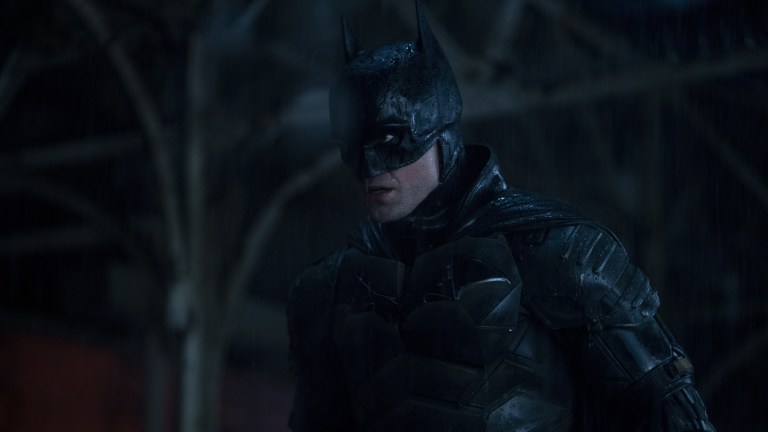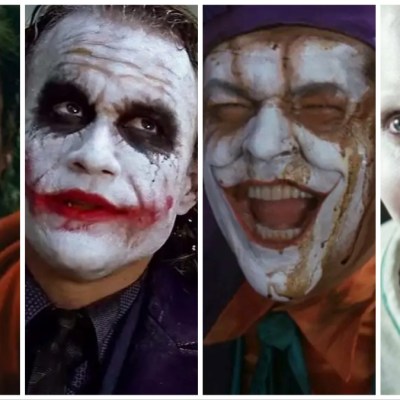What The Batman Final Scene Means for Sequels
The final scene of The Batman teases big things to come in Gotham City. Director Matt Reeves tells us exactly what it means.

This article contains The Batman spoilers. We have a spoiler-free review here.
As far as teases go, it’s not exactly a subtle one. The final scene in The Batman gives us a look at the Riddler, alone in his cell at Arkham Asylum, although not truly alone. In the cell next to his sits a shadowy, scarred figure, one barely glimpsed through the tiny, reinforced window on the door, who is trying to comfort the agitated and defeated villain.
And yes, it’s exactly who you think it is…
The Joker
It’s probably no surprise to anyone that The Batman found a way to introduce the Joker into its version of the Dark Knight’s early career. The Joker is arguably the most commercially viable villain this side of Darth Vader, and arguably the most recognizable comic book and pop culture supervillain of all time. A Batman-free, R-rated Joker solo movie just managed to score itself a billion dollars at the box-office and an Oscar win for its star, for cryin’ out loud. You really think Warner Bros. wasn’t going to find a way to get the Clown Prince of Crime in here?
That’s Barry Keoghan (recently seen doing superhero movie double duty as Druig in Marvel’s The Eternals) bringing Joker to life here. We hear him, but we don’t fully see him. And there’s a reason for that, which we’ll get to in a minute. But The Batman director Matt Reeves wants everyone to be aware that this isn’t quite the Joker we all know and loathe. At least not yet.
Who is the new Joker in The Batman?
The Joker’s origin story has become somewhat malleable throughout the decades. For most of his history, both in the pages of the comics and on screen, he was a criminal who fell into a vat of chemicals that permanently stained his body and drove him mad. This was adapted slightly for Jack Nicholson’s Joker portrayal in Tim Burton’s 1989 Batman. Heath Ledger’s Joker from The Dark Knight was a man in makeup, but who had received hideous scars that made it appear like he was smiling. Joaquin Phoenix’s Joker was also a disturbed man in makeup, although one who had a condition that made him laugh uncontrollably and at inappropriate moments.
It sounds like the version of the Joker that we meet at the end of The Batman is a little different from all of them, however.
“The idea is that what you’re seeing is a pre-Joker, Joker actually,” Reeves says. “So it will be critical that he be different. I was working with Mike Marino who did Colin’s [Farrell] makeup, and he did Barry’s [Keoghan] makeup as well. The conception that I wanted was that we’d go back to the Conrad Veidt, The Man Who Laughs inspiration, which is the Bob Kane, Bill Finger reference [for the character]. And in that [movie], obviously that guy has a congenital disease. He’s like the Phantom of the Opera, he can’t not smile. So I was like, ‘wouldn’t it be interesting if this origin was not a vat of chemicals or some unexplained scars like the Nolan Joker?’ What if we did something where he had a congenital disease?’”
We can see the barest hint of this in the Arkham Asylum scene, as Joker does clearly have some kind of permanent grin, as well as possibly some additional scars. And while it’s hard to tell, he doesn’t seem to have the chalk-white skin or bright red lips of a “post-Joker” look. However, for the moment, Reeves seems much more concerned with the backstory and motivation of the character, and how his look affects him.
“We were actually talking about The Elephant Man,” Reeves says. “I’m a huge David Lynch fan. What if this guy’s whole worldview was formed by the fact that life had played this cruel trick on him? Life made a joke out of him and he could never not smile and he had a lifetime of people staring at this grotesque smile that he had no control over. [So] instead of being like the story of The Elephant Man, where all of his grotesque outward appearance belied the beautiful inside, this would form [Joker’s] nihilistic worldview. He would have a kind of insidious understanding of human nature and everything was framed through that lens of fate playing a cruel joke on you from childhood. So that’s kind of where the psychology comes from, in who this guy would be.”
Will The Joker Appear in The Batman Sequel?
But the thing is, we’ve already had so many memorable big screen Joker performances, it’s hard to imagine where Reeves and Keoghan could take Batman’s story that it hasn’t been already in recent years. The Batman director wants everyone to be aware of is that Joker isn’t even a lock to appear in The Batman 2.
“As to whether we would actually do the Joker in future movies…his appearance at the end of the movie is really more contextual,” Reeves tells us. “I can’t say whether we would do him specifically in the movies or not. But if we do, I had a whole sort of backstory on what his genesis was and what that was about.”
Could the Joker and Riddler Team Up in The Batman 2?
One thing that seems to be happening in this scene is that Joker is advising Riddler. He even utters what is generally considered to be Riddler’s catchphrase (coined on the 1966 Batman TV series) of “Riddle Me This.” The Batman is certainly an origin story for Catwoman and Penguin, but what if it’s also Riddler’s origin story, in that the character isn’t fully formed yet? Perhaps the influence of the Joker makes him take on a less menacing, serial killer-y modus operandi in favor of a more flamboyant, outrageous one?
That, of course is pure speculation on my part, and since Reeves has already expressed that he isn’t sure yet who the villain of the next movie will be, it will have to remain as such for a while. However, it’s worth noting that Joker almost had a larger role in the film, and there’s a deleted scene we may get to see one day. We have more on that here.
The Batman is now playing in theaters everywhere.

